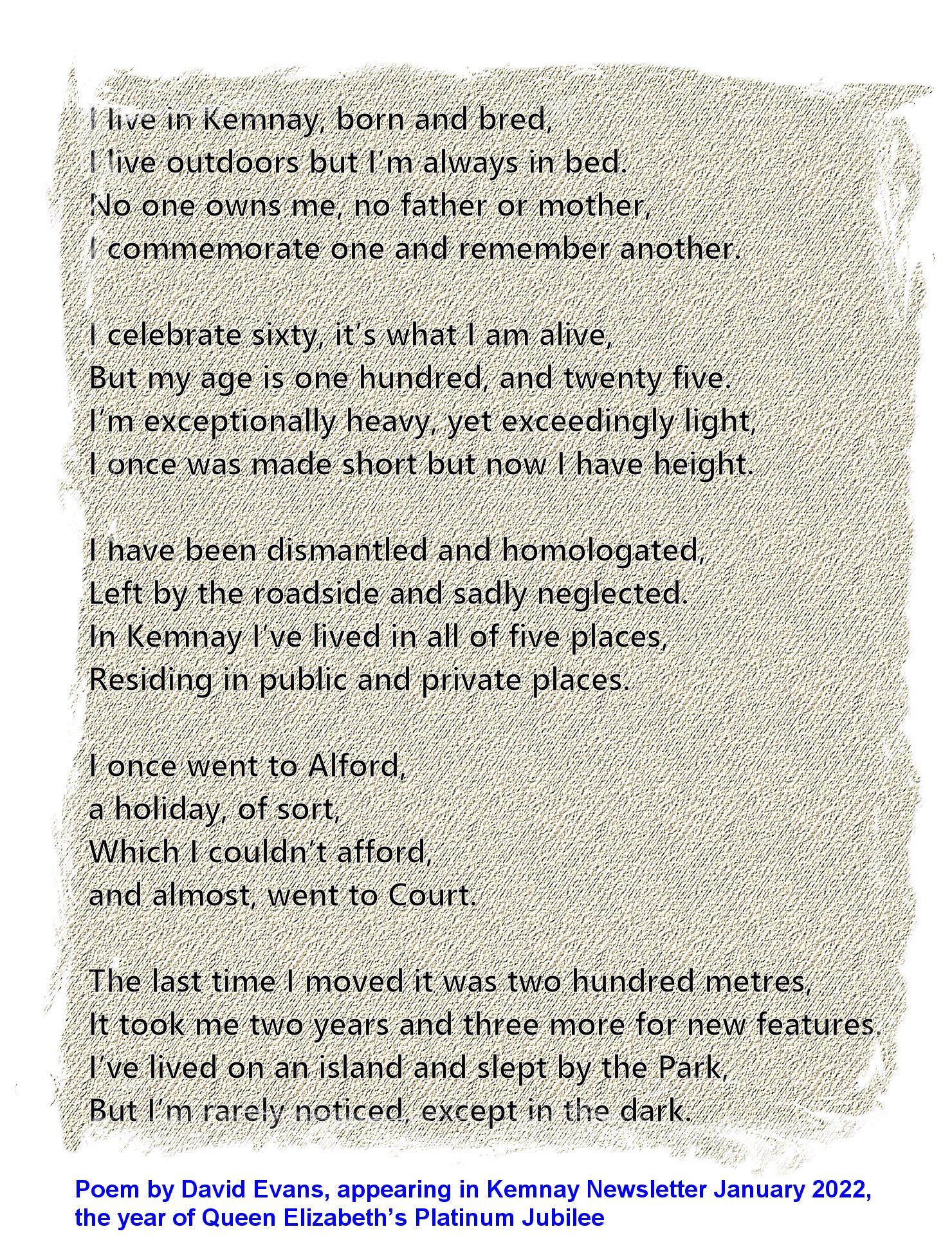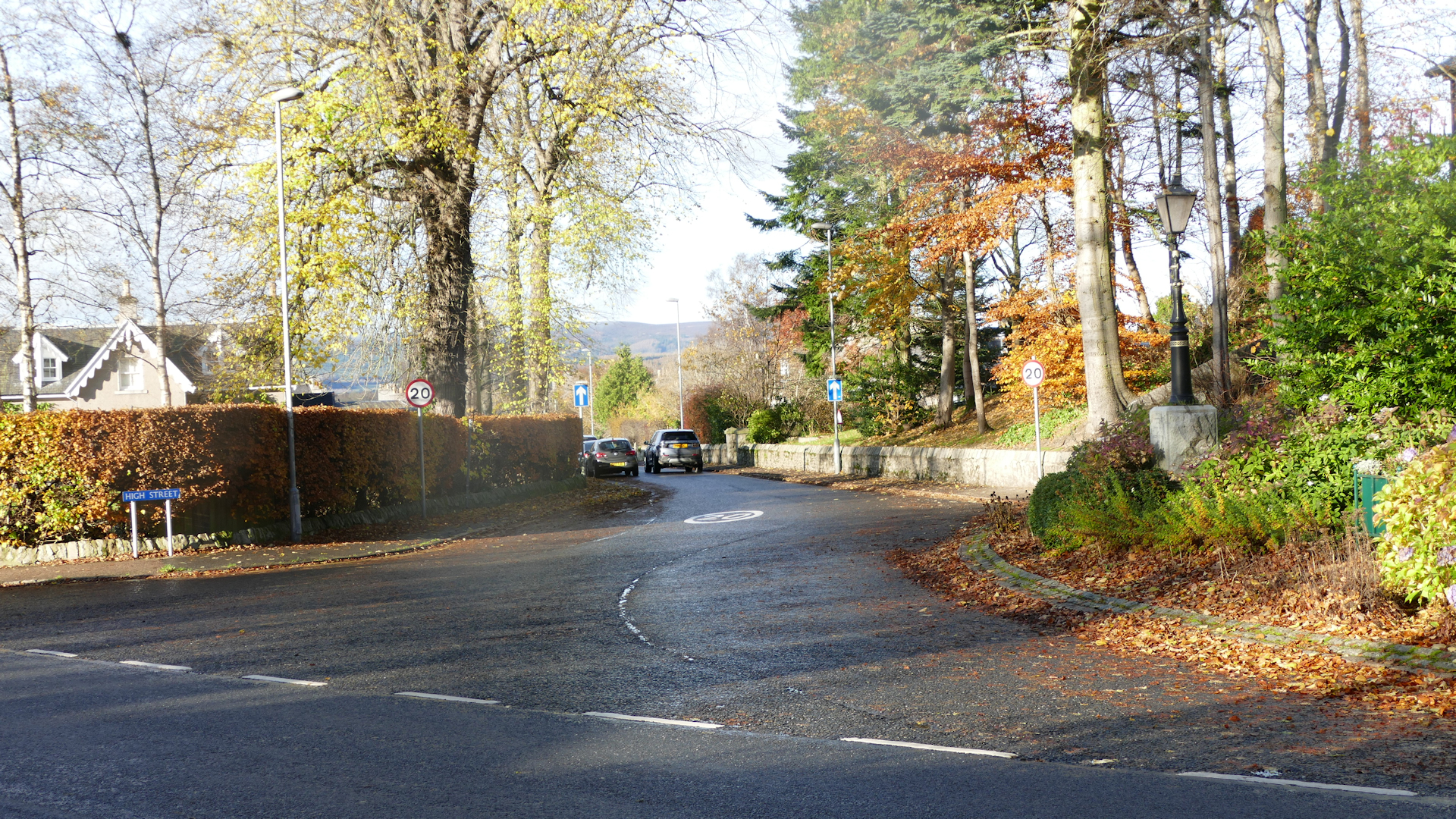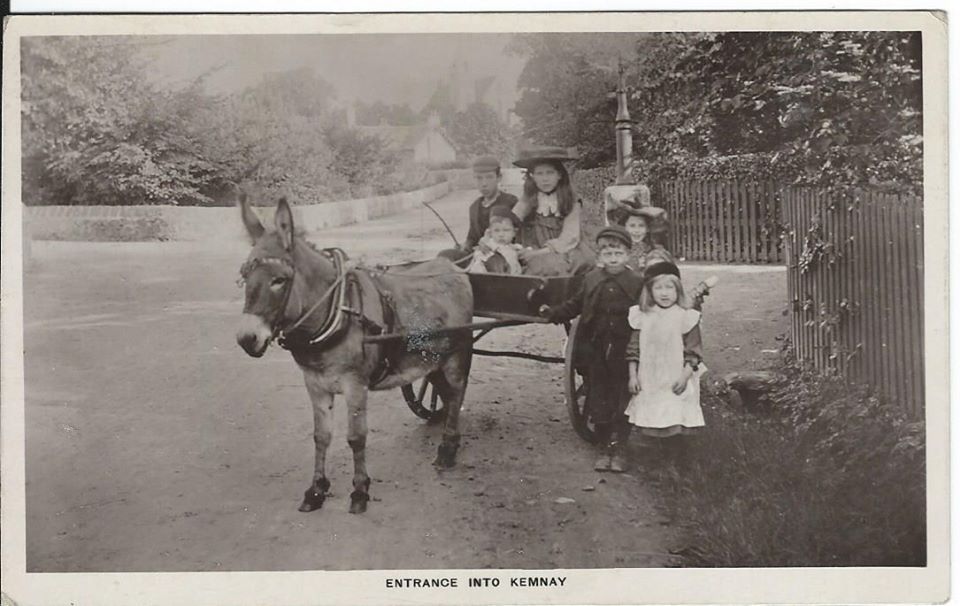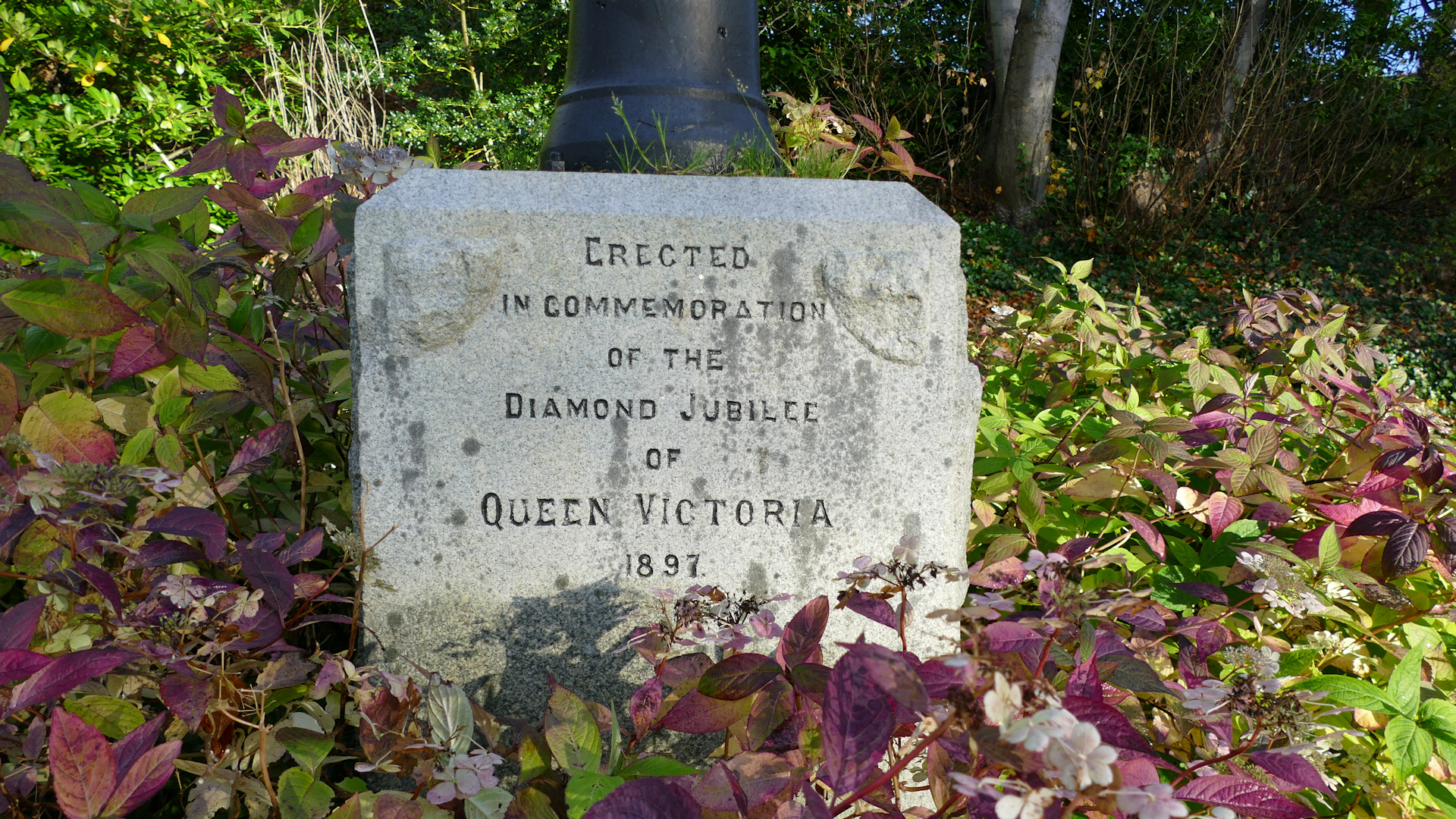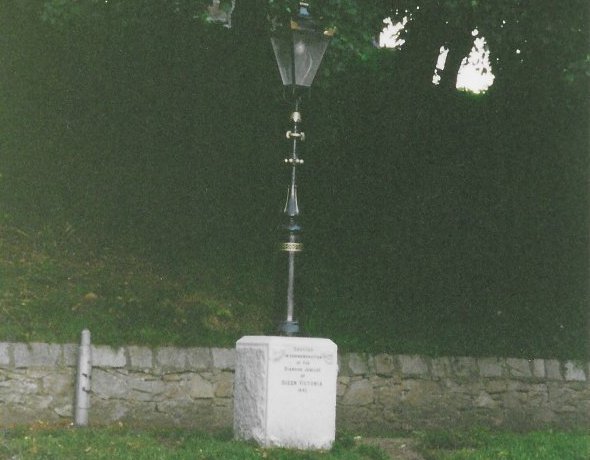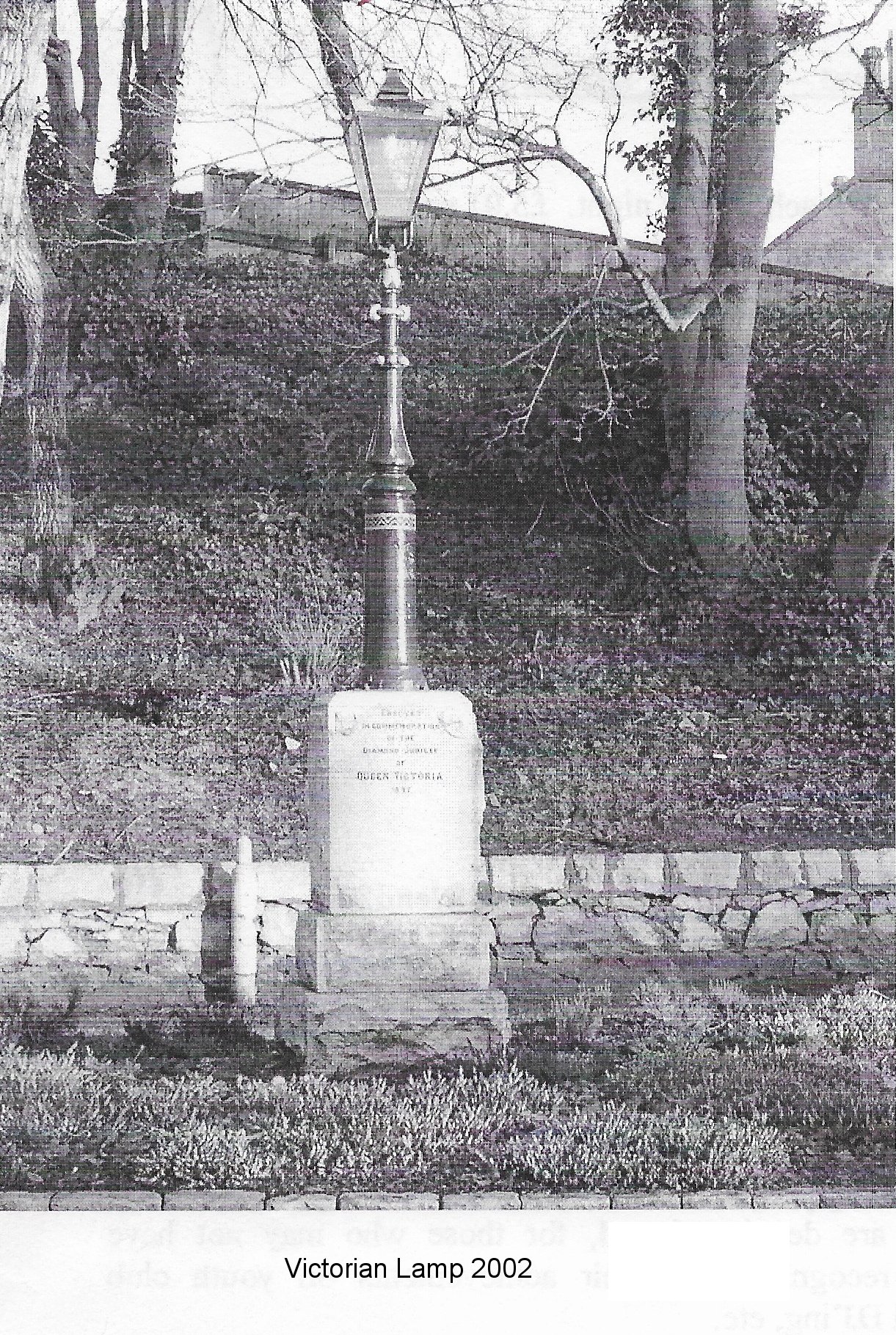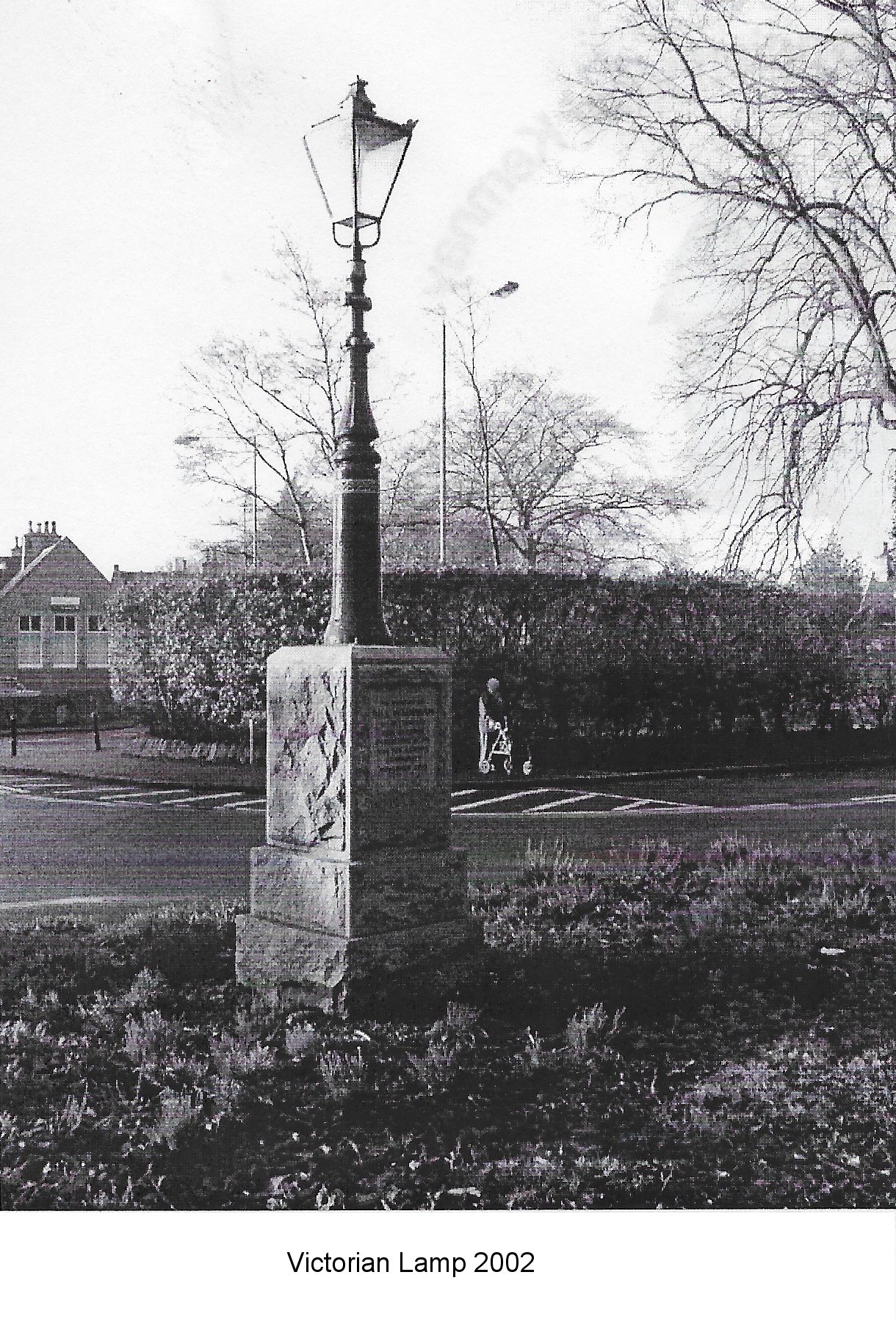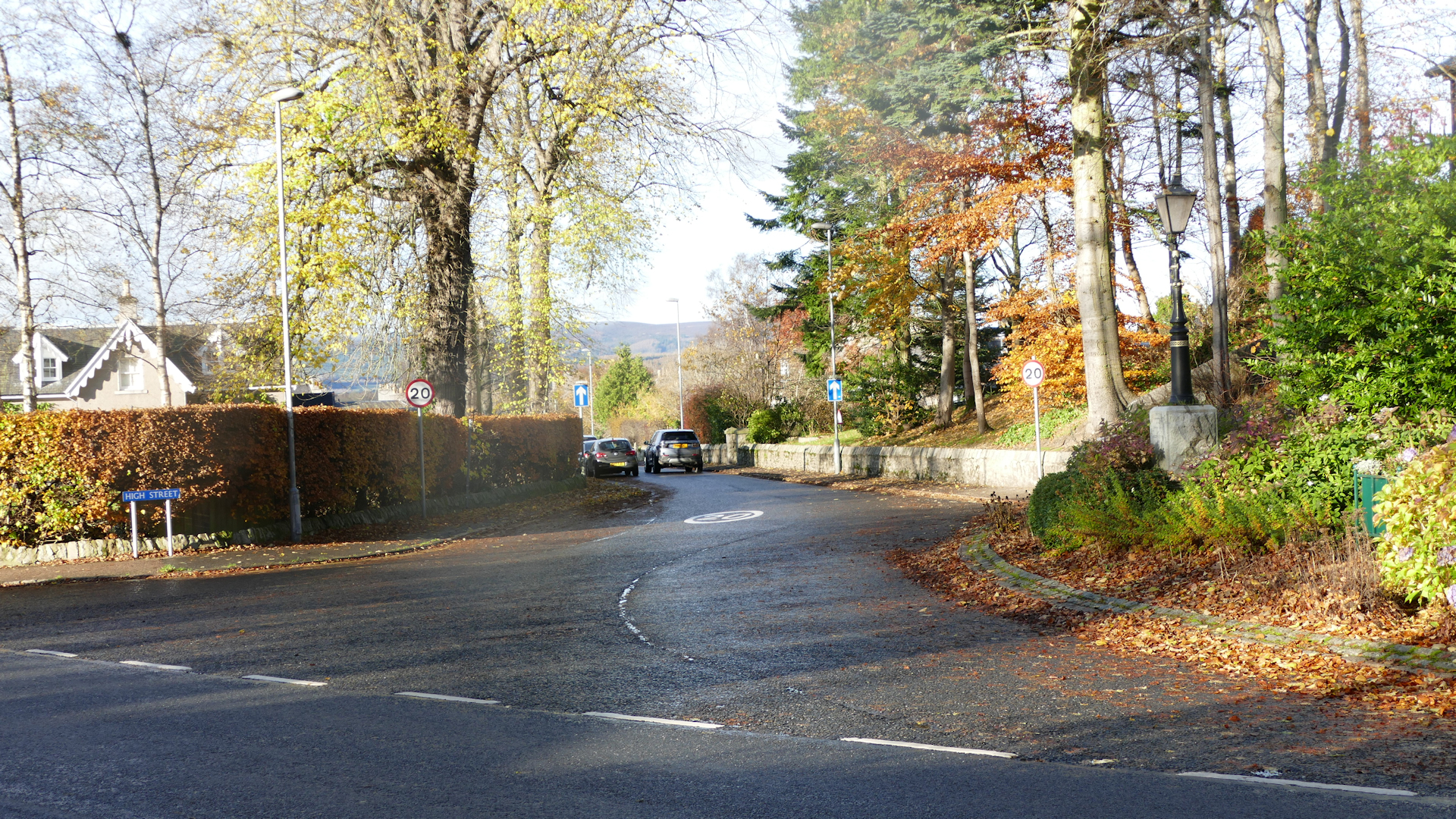Victorian Diamond Jubilee Lamp
The Diamond Jubilee of Queen Victoria was celebrated on 20 June 1897 on the occasion of the sixtieth anniversary of Queen Victoria’s accession on 20 June 1837. In celebration of the occasion, a Victorian Diamond Jubilee Lamp was erected at the entrance to the house named The Grove. The immediately above photo, taken circa 1912, shows the lamp in the background and its position is shown marked in blue on the map below. It would have been just ornamental or lit by a candle at that time. The Grove was the residence of William Kendall Burnett, a son of Alexander George Burnett, the Laird.
Presently, there is no information regarding who actually purchased and installed the lamp, it was at the entrance to The Grove so it could have been purchased by the Laird’s son William Kendall Burnett but anecdotal evidence would suggest that this is unlikely. It is more likely that it was purchased by the Parish Council and a search of the Parish Council or County of Aberdeen minutes around 1897 might throw some more light on the matter.
The lamp was later relocated to a small grassed island opposite the school gate between Grove Road and High Street, shown marked in yellow on the map. At this time it was electrically powered and formed part of the street lighting system. There is no information to indicate the date of relocation other than the fact that Kendall Burnett died in 1912 and the property was then sold, so maybe it was moved then or maybe later when Kemnay had street lighting installed.
 The Grove Road High Street junction was realigned circa 1974. A letter from KCC to AC dated 5th October 1998 suggests that AC removed the lamp to a temporary storage site at the side of Bogbeth Road (approximate position is shown marked green on the map), at the time High Street was designated one-way. During the period of temporary storage at the Bogbeth road site, the two lower granite base sections went missing.
The Grove Road High Street junction was realigned circa 1974. A letter from KCC to AC dated 5th October 1998 suggests that AC removed the lamp to a temporary storage site at the side of Bogbeth Road (approximate position is shown marked green on the map), at the time High Street was designated one-way. During the period of temporary storage at the Bogbeth road site, the two lower granite base sections went missing.
The Grove site was later sub divided, a house now known as The Gask, was erected in the rear garden area and the original house and remaining land was sold and later in September 1987 was subject of a planning application for change of use to a Nursing Home, which is now Grove Nursing Home. The lamp and remaining granite upper base was eventually relocated to the garden at The Gask. It is unclear when this happened, it could have still been the back garden of The Grove when it was relocated but an approximate position is shown marked location 4 pink on the above map. It is unclear why it was moved or who moved it but KCC letter dated 29th April 1999 states that it was relocated by AC.
Circa 1990, a mobile home was sited in the front garden area of The Gask, the plot was later further sub-divided and in December 1997 a planning application was submitted to build a house on the site of the mobile home, a site which included the Victorian lamp. The planning application was subsequently approved with a condition that the 100 year old commemorative lamp should not be removed without the consent of the Director of Planning.
In a letter dated 30th January 1998, Kemnay Community Council (KCC), Chaired by Bill Wainman, wrote to the Director of Planning to request that the commemorative lamp be moved to as close as its original position at the High Street Grove Road junction, shown marked in red on the map. The suggestion was on the basis that Aberdeenshire Councillor Leitch understood that the applicant was willing and agreeable to such relocation. The Director of Planning later replied agreeing to the proposal. Furthermore, handwritten notes by Bill or Mavis Wainman, circa May 1998, state that the developer of the house site intended to put the lamp in a rubbish ‘skip’ but asked KCC if the community wanted it back.
At the KCC March 1998 meeting, there were no objections regarding relocation of the lamp but cost may be an issue so a letter was sent to Aberdeenshire Council (AC), regarding available options for accomplishing the relocation.
This marked the beginning of a protracted two year endeavour to save the lamp from being dumped in a rubbish ‘skip’. It was a very long and frustrating affray in which KCC suffered homologation , an invoice from Aberdeenshire Council for £68.62, Final Notice with threats of Court action and further threats of Court Action from H H Cameron Debt Recovery … all just to simply have the lamp moved approximately 200 metres east to its present location in the High Street. The persistent determination of Kemnay Community Council, adamantly led by Chair Bill Wainman, continued unrelentingly to ensure that common sense should finally prevail over bureaucracy and eventually a Credit Note was issued for the “perceived” overdue debt. Two years later, on 30th November 1999, the Victorian Lamp was finally reinstated to a place in the High Street flower bed. Sadly its ‘champion’, Bill Wainman, passed away on 6th November 1999, just 24 days before the event. As recorded in minutes of the KCC meeting on 25 November 1999:
“VICTORIAN LAMPOST This is to be finally erected at the entrance to the High Street opposite the Primary School at 4.20 pm on Tuesday 30th November 1999. It will bear a plaque to the memory of Bill Wainman, late Chairman of KCC, to mark his continued efforts to have this particular installation happen”
However, the saga did not end there but continued right up until 2002. If you wish to read all the details they are listed below.
At KCC meeting on 30 April 1998 (item 5), a reply from AC indicated that the cost of the relocation operation would be £1,100.00 including disconnection, transport to AC Harlaw Depot for treatment and painting and conversion to 100w., installation and reconnection. KCC Chair to write to Painters to get quotes for painting.
On 6th April 1998, Bill Wainman, Chair of KCC, wrote to AC asking if the cost of the project could be covered by way of a Community Council Project Grant. AC replied stating that the project could be suitable to qualify for such a grant but KCC would have to carry out the work or arrange for a Contractor to do so in which case KCC should approach contractors of their choosing to tender their quotes.
On 29th April 1998, AC Head of Service, Transport & Roads, wrote to KCC detailing the work to be undertaken and the overall cost which was £1,100.00. Estimates for the final painting of the lamp were received from two contractors, one was £385.00 and the other was free of charge if paint was supplied. KCC wrote to AC on 20th May 1998 advising that the total ‘maximum’ cost of the project would be £1,100.00 + £385.00 + VAT.
On 14 May 1998, AC Area Manager wrote to KCC confirming that planning permission would not be required to move / relocate the lamp and requesting estimates for the work to be undertaken from at least one contractor. It was always assumed that the estimates referred to were for final painting of the lamp.
Notes written by Bill / Mavis Wainman circa May 1998 state that the developer of the new house site, on which the lamp presently stands, intended to put the lamp in a skip but asked KCC if the community wanted it back.
On 20 May 1998, KCC replies to AC letter dated 14 May 1998, the second paragraph is of particular relevance and states: “When we met with AC Lighting Engineer (who attended KCC meeting on 30/04/98), he told us that the major cost of the project would be work of necessity undertaken by his department and that he considered that it would be advantageous if the whole work apart from the painting was done by AC. This is important because it sensibly means that restoration and relocation of the lamp was in reality just routine maintenance and the project cost was effectively irrelevant because it was in essence just part of costs that are incurred on a day to day basis. If common sense had prevailed over bureaucracy at this stage of proceedings, a lot of needless and pointless work could have been prevented.
Two replies were received from AC Area Manager on 28 May 1998 and 25 June 1998, the latter of which expressed surprise at the ‘high’ cost of the project £1,485.00 and explaining that the maximum amount available for a Project Grant was £700.00. There was a possibility of further funding by way of a Facelift and Amenity Grant but unfortunately it was tied to a maximum of 50% of project BUT … the other 50% of the cost cannot be funded from any other source from within the Council i.e. a Project Grant!
It is somewhat irrational that AC Area Manager should be asking KCC to reduce the cost of the project, which had been set by AC Head of Service Transport & Roads! Furthermore, at an earlier meeting with an AC Lighting Engineer, KCC were advised that the major work and cost would of necessity be incurred by his department so there would be no need to contact any other Contractor to gain estimates for the work. KCC replied to AC Area Manager on 29 June 1998 explaining the situation and suggesting he should discuss any reduction in costs with AC Head Of Service Transport & Roads, who had costed the work.
In the absence of further correspondence from AC, KCC Chair wrote to AC Area Manager on 5th October 1998 drawing his attention to the fact that the lamp had originally been removed from its location in High Street in the early 1970’s when AC altered the junction and designated the High Street ‘one way’. This being the case, perhaps AC would care to reinstate the lamp to its former position. There was a further ‘helpful’ suggestion that funding may be available by way of a Funding For Art contribution from the Developer of a local housing scheme.
To add to the dilemma, the owner of the site on which the lamp presently stood, wrote to KCC on 11 December 1998 requesting confirmation that KCC required reinstatement of the lamp to a suitable position in the village and requesting that it be removed expeditiously to avoid any damage that may occur accidentally during construction of the new house. A copy of the letter was passed to AC for information.
On 21st December 1998 AC replied suggesting that in view of the imminent development of a house on the site where the lamp was located, to avoid any accidental damage the lamp could be removed by AC to a secure storage area at a cost of £200.00 which would be deducted from any Project Grant of £700.00. It was further stated that the original project cost of £1,100.00 could not be reduced and therefore the cost of the shortfall could possibly be met in part by an additional ‘rescue’ grant. This further grant, IF agreed by Committee, would not cover the full cost of the project but would give KCC time to raise money within the community or apply for a ‘Millennium Small Grant’ to cover the shortfall.
There was a further possibility if there was a shortfall in uptake in the budget for CC Project Grants in the current financial year, the Area Committee may consider making available additional resources for specific projects. Another possibility would be for the shortfall to be met by another Project Grant from the budget for the next financial year, which would be phased funding .
On 22nd December 1998, KCC Chair Bill Wainman replied agreeing to removal and secure storage of the lamp and pointing out that one painting contractor had offered to paint the lamp free of charge if suitable paint was supplied, which would reduce the project cost to just that of the AC costings which was £1,100.00. He also took the opportunity to remind AC that it was the local authority that removed the lamp from High Street and relocated it to its present site at The Gask.
A year has now passed since the planning application to erect a house in the garden of the Gask was and still is located.
On 2nd February 1999, AC Area Manager wrote to KCC to confirm that a Project Grant of £700.00 has been awarded to KCC and further states “this includes homologation of the sum of £200 for rescue of the lamp and secure storage”. The use of the word “homologation” was somewhat confusing, the definition is “the granting of approval by an official authority”, and it wasn’t really clear what is meant? KCC understanding of the original proposal was that if the Project Grant of £700 was approved, £200 would be deducted immediately to cover the cost of removal and secure storage. The grant is also subject to four somewhat ridiculous conditions, one of which relates to assurances regarding long term maintenance of what is in reality an AC lamp and another relating to the work being of a satisfactory quality … when it was AC that was to carry out the work!
Due to the confusing use of the word ‘homologation’ KCC replied to AC Area Manager on 4th February 1999 requesting clarification, amusingly, the final paragraph of the letter stated “I hope for a satisfactory outcome as I hope that the lamp will be reinstated in good time for Queen Elizabeth’s Diamond Jubilee”.
On 15th February 1999, AC Area Manager replies to confirm the award to KCC was £700, there is no mention of the word ‘homologation’ and no mention of the £200 cost of removing, transporting and secure storage of the lamp. It is however confirmed that no alteration has been made to the original project cost of £1,100.00. It is also intimated that there may be access to additional funds if there is a budget take-up shortfall for the current financial year but even if such was awarded it would not bridge the shortfall. It is remarkable that AC still do not understand or probably more accurately will not admit that the lamp belongs to them?
The 21st of April 1999 marks another astonishing turn of events when KCC are in receipt of an invoice from AC for the amount of £68.62, which relates to removal of Victorian lamp from Grove Nursing Home, Kintore and transportation of the lamp to an unknown destination. The invoice is to Kemnay Community Association, instead of Council and is incorrectly addressed to Blythewood House, Main Street, Kemnay. What had happened to the AC specified cost of £200, remains a mystery, maybe it had been homologated?
On 29th April, KCC wrote to AC Area Manager somewhat tediously explaining that the lamp is Aberdeenshire Council property and formed part of the Kemnay High Street lighting system until AC removed it during road realignment circa 1970 and later relocated it to private land at The Grove. The letter further states that KCC has no other interest in the matter other than wishing to see the lamp restored to its position in the High Street.
On 30th April 1999, a letter is received from AC Area Manager stating that an additional grant of £233.98 has been awarded to KCC bringing the total to £933.98 (at least the Area Manager could count). The invoice for transportation and storage amounting to 68.62 will be amended … to this time include VAT! If KCC have insufficient funds to pay the invoice, they should apply to AC for early release of the grant funds to pay the invoice. AC is quite remarkably in denial of the fact that it owns the lamp and this whole farce is becoming a ridiculous bureaucratic nightmare!
On 31st May a ‘Final Notice’ is received from AC Director Of Finance stating if the debt is not paid within seven days, he will commence recovery proceedings and KCC may be liable for any additional costs incurred in collecting the debt. Furthermore, Court Action may affect KCC’s future ability to obtain credit.
On 18th June 1999, debt recovery company M M Cameron write to KCC threatening Court action if the debt of £68.62 is not paid within seven days. KCC respond by sending a copy of their letter to AC Area Manager dated 29 April 1999 to MM Cameron for information.
No other written communication from either AC or MM Cameron is available in KCC files but on 14th July 1999, a Credit Note is received from AC to the value of £68.62, which effectively cancels the so called debt.
There is a somewhat sad ending to this saga in that the Victorian Lamp was finally reinstated to its place in the High Street on 30th November 1999 but sadly its ‘champion’ Bill Wainman passed away on 6th November 1999, just 24 days before the event. Recorded in the KCC minutes of the meeting on 25th November 1999, Chaired by Dr. Jim Piggins, is the following:
UNFINISHED BUSINESS (C) VICTORIAN LAMPOST This is to be finally erected at the entrance to the High Street opposite the Primary School at 4.20 pm on Tuesday 30th November 1999. It will bear a plaque to the memory of Bill Wainman, late Chairman of KCC, to mark his continued efforts to have this particular installation happen.
However, the story does not end there. You will recall that the granite base of the lamp originally sat on two lower granite bases, which mysteriously disappeared while lying in temporary storage at the side of Bogbeth Road. KCC secretary Chris Hunneyball OBE contacted AC on 14th October 2001 to enquire if the two missing lower granite bases were still in storage on AC premises but AC replied on 31st October 2001 stating that no such bases were present when the lamp was removed from the site at The Gask.
Bill’s wife Mavis Wainman, KCC member and former Aberdeenshire Councillor, volunteered to pay for the replacement of the two ‘missing’ lower granite bases. On 1st July 2002, Fyfe Memorials supplied a quote of £1,315.00 for the work. Included in this cost was reworking the face of the existing plinth because the inscription lettering was off square and required to be re-cut and repainted.
On 4th July 2002, Mavis Wainman wrote to AC to ask if AC would be willing to pay (and reclaim) the VAT on the two granite base sections that she was prepared to pay for. On 25th July 2002, AC replied that they were unwilling to do so because, astonishingly, the lamp belongs to ‘The Community Association’ (not even Kemnay Community Council). AC is obviously still in denial about ownership of the lamp. AC did however offer to cover the cost of disconnecting and reconnecting the electricity supply. Mavis has added a handwritten comment on the bottom of this letter which reads:
“It is difficult to understand how this lamp belongs to the Community Association when it was erected in Queen Victoria’s time”.
The new base was finally completed later in 2002 so it only took five years to restore the lamp to its former state and position and hopefully it will not be moved again
A report in Kemnay Newsletter December 2004 briefly described the whole saga. The consistent attitude of AC was and seemingly still is one of denial of ownership of what is effectively part of Aberdeenshire heritage. The Council has never admitted that it owns the lamp and just literally ignored all such suggestions. Where KCC maybe went wrong was at the outset when they should have questioned the validity and purpose of the relocation / refurbishment cost of £1,100.00. It was in effect a meaningless and irrelevant cost because any cost should have been absorbed into normal AC maintenance and refurbishment of its own equipment. Referring back to KCC letter to AC Area Manager dated 20 May 1998, the second paragraph is of particular relevance and importance and states: “When we met with AC Lighting Engineer (who attended KCC meeting on 30/04/98), he told us that the major cost of the project would be work of necessity undertaken by his department.
A final thought on the matter, if this had occurred in 1897, maybe the Laird Alexander George Burnett or his son William Kendall Burnett would have simply organised a squad of local men to carry out the work. All that was required was to move the lamp a few hundred yards across the road. It could probably have been accomplished in one day rather than two years, but I suppose that’s progress.

